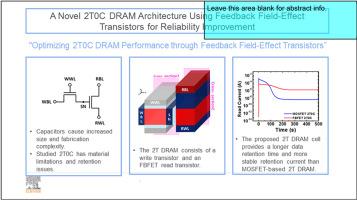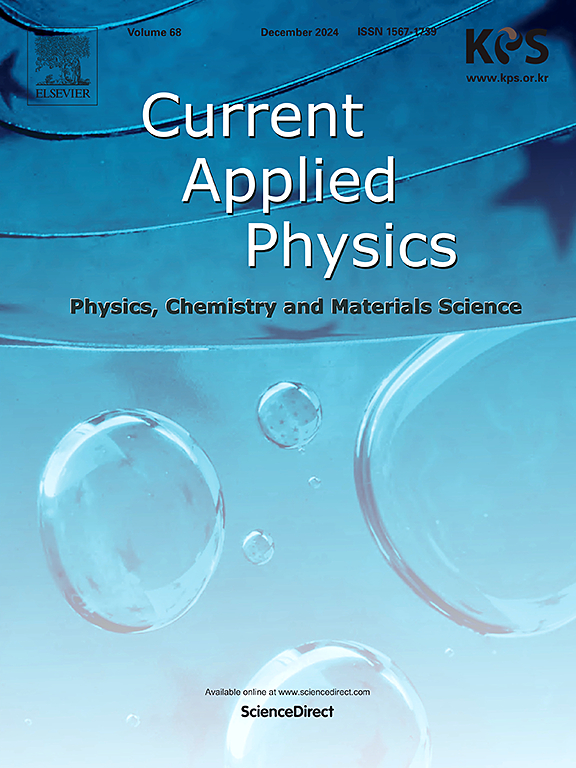A novel 2T0C DRAM architecture using feedback field-effect transistors for reliability improvement
IF 3.1
4区 物理与天体物理
Q3 MATERIALS SCIENCE, MULTIDISCIPLINARY
引用次数: 0
Abstract
Scaling challenges of conventional one-transistor one-capacitor (1T1C) dynamic random-access memory (DRAM), such as increased refresh power consumption and the manufacturing complexities of high-aspect-ratio capacitors, have highlighted the need for alternative memory architectures. This work introduces a novel two-transistor (2T) DRAM architecture employing a feedback field-effect transistor (FBFET) as the read transistor in the memory cell. By eliminating the need for a charge-storage capacitor, the 2T structure effectively addresses scalability limitations. The positive feedback mechanism instrinsically expected in a FBFET enables a high ON/OFF current ratio, rapid switching, and stable read operations without requiring additional voltage sources. Through a series of Sentaurus technology computer-aided design (TCAD) simulations, the proposed 2T DRAM cell demonstrated significant improvements in retention time, storage node voltage stability, and read current accuracy compared with previous 2T DRAM cells composed of only metal-oxide-semiconductor field-effect transistors (MOSFETs). The influence of critical parameters including write bitline voltage (VWBL) and channel length (LCH) have been systematically analyzed. The results show that a shorter channel length enhances the positive feedback, while longer one degrades retention time due to elevation of energy barrier. Furthermore, the impact of the read transistor's gate oxide thickness has also been evaluated. Thicker oxide layers weaken gate control over the channel, leading to faster voltage decay at the storage node (SN) and reduced read current. The proposed 2T DRAM cell design achieves superior data retention, reduced refresh dependency, and enhanced energy efficiency, overcoming the limitations of conventional DRAM cell. These findings underscore the potential of the FBFET-embedded 2T DRAM cell for the next-generation memory applications in the data storage and hardware-oriented artificial intelligence (AI) chips.

采用反馈场效应晶体管的2T0C DRAM结构提高了可靠性
传统的一晶体管一电容(1T1C)动态随机存取存储器(DRAM)的缩放挑战,如刷新功耗增加和高宽高比电容器的制造复杂性,突出了对替代存储器架构的需求。本文介绍了一种新的双晶体管(2T) DRAM架构,采用反馈场效应晶体管(FBFET)作为存储单元中的读晶体管。通过消除对电荷存储电容器的需求,2T结构有效地解决了可扩展性限制。FBFET固有的正反馈机制使得高开/关电流比、快速开关和稳定的读取操作无需额外的电压源。通过一系列Sentaurus技术计算机辅助设计(TCAD)模拟,与之前仅由金属氧化物半导体场效应晶体管(mosfet)组成的2T DRAM电池相比,所提出的2T DRAM电池在保持时间、存储节点电压稳定性和读取电流精度方面都有显著改善。系统分析了写入位线电压(VWBL)和通道长度(LCH)等关键参数对系统性能的影响。结果表明,较短的通道长度增强了正反馈,而较长的通道长度由于能量势垒的升高而降低了保持时间。此外,还评估了读晶体管栅极氧化物厚度的影响。较厚的氧化层削弱了栅极对通道的控制,导致存储节点(SN)的电压衰减更快,读取电流降低。提出的2T DRAM电池设计实现了卓越的数据保留,减少了刷新依赖,提高了能源效率,克服了传统DRAM电池的局限性。这些发现强调了fbfet嵌入式2T DRAM单元在数据存储和面向硬件的人工智能(AI)芯片中的下一代存储器应用的潜力。
本文章由计算机程序翻译,如有差异,请以英文原文为准。
求助全文
约1分钟内获得全文
求助全文
来源期刊

Current Applied Physics
物理-材料科学:综合
CiteScore
4.80
自引率
0.00%
发文量
213
审稿时长
33 days
期刊介绍:
Current Applied Physics (Curr. Appl. Phys.) is a monthly published international journal covering all the fields of applied science investigating the physics of the advanced materials for future applications.
Other areas covered: Experimental and theoretical aspects of advanced materials and devices dealing with synthesis or structural chemistry, physical and electronic properties, photonics, engineering applications, and uniquely pertinent measurement or analytical techniques.
Current Applied Physics, published since 2001, covers physics, chemistry and materials science, including bio-materials, with their engineering aspects. It is a truly interdisciplinary journal opening a forum for scientists of all related fields, a unique point of the journal discriminating it from other worldwide and/or Pacific Rim applied physics journals.
Regular research papers, letters and review articles with contents meeting the scope of the journal will be considered for publication after peer review.
The Journal is owned by the Korean Physical Society.
 求助内容:
求助内容: 应助结果提醒方式:
应助结果提醒方式:


